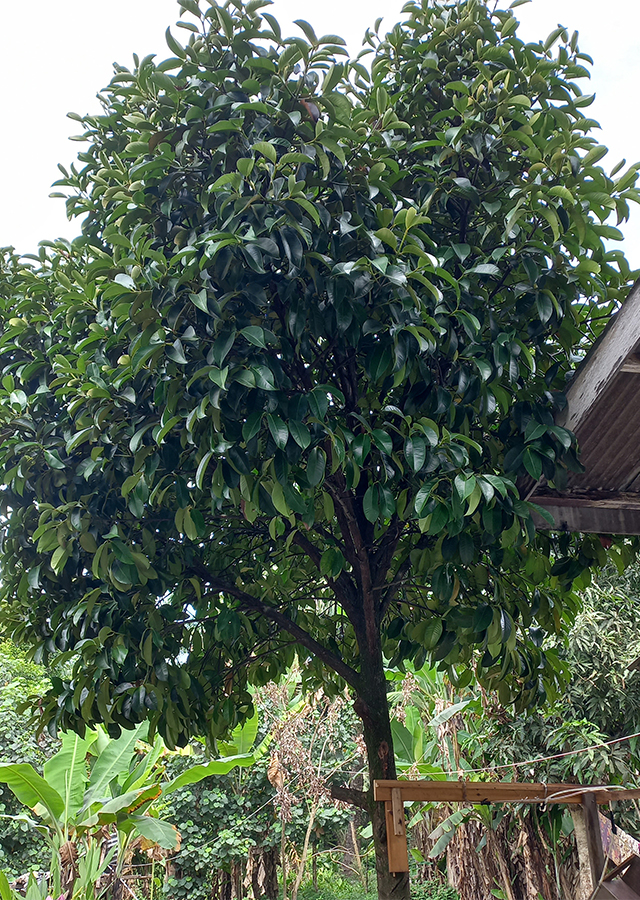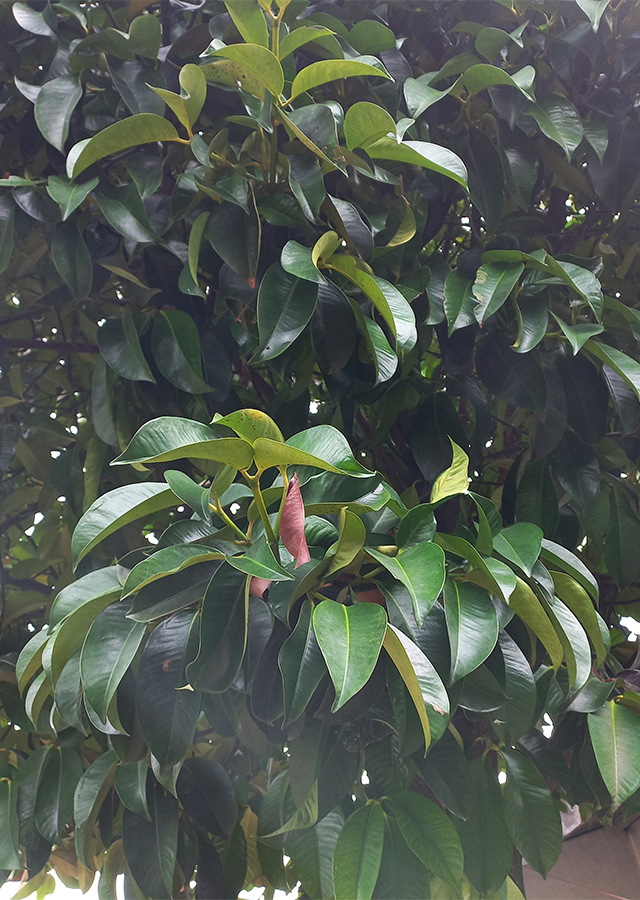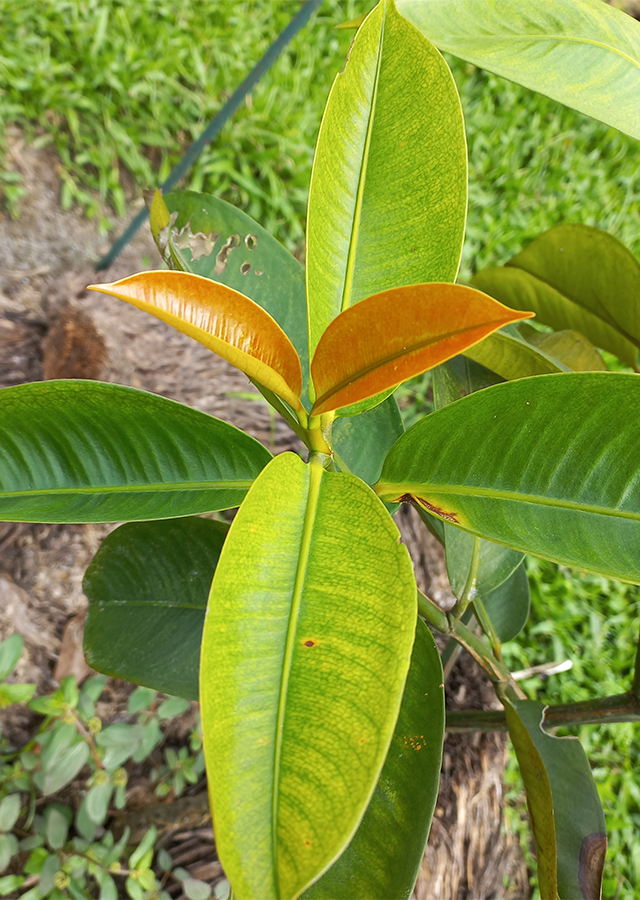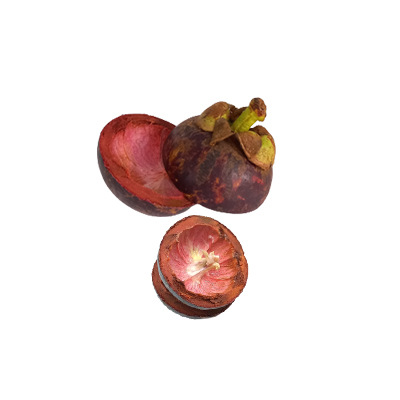Mangosteen
Garcinia mangostana L.
Clusiaceae
Location in our garden
Orchard



Synonym
Mangostana garcinia Gaertn.
Habitus
Trees. A very slow-growing evergreen tree with a pyramidal crown. It can grow up to 25 metres tall, but is usually much smaller, especially in cultivation.
Part Used
Leaves
Bark
Rind
Roots
Growing Requirements
Full Sunshine
Need Shade
Habitat
Forest
Terrestrial
Overview
The mangosteen is only known as a cultivated species, although there have been occasional reports of wild specimens in Malaysia. It closely resembles G. hombroniana Pierre and G. malaccensis T. Anderson, which are indigenous in Malaysia (the former is also indigenous in the Nicobar Islands). The mangosteen may be an allotetraploid hybrid of these two species; if so, it originated in Peninsular Malaysia. Cultivation has long been limited to South-East Asia, ranging from Indonesia eastwards to New Guinea and Mindanao (the Philippines) and north via Peninsular Malaysia into the southern parts of Thailand, Burma and Vietnam, and to Cambodia. Only during the last two centuries has the crop spread to other tropical areas, including Sri Lanka, South India, Central America, Brazil and Queensland, where orchards now cover small areas. The mangosteen is probably the most highly praised tropical fruit. It is mostly eaten fresh, since preserved forms are far less appealing. The fruit rind is used to tan leather and to dye black. Both the rind and the bark have several applications in traditional medicine. The dark red wood is heavy, coarse and very strong; when available it is used in carpentry and to make rice pounders.
Vernacular Names
Mangosteen (English), Mangoustan (Franch),Manggis (Indonesia), Manggis (Malaysia), Manggustan, Manggis (Philippines), Mingust (Burma), Mingut (Myanmar, Mongkhut (Cambodia), Mangkhud (Laos), Mang-Khut (Thailand), Cây măng cụt (Vietnam).
Agroecology
The mangosteen is an ultra-tropical plant, usually only grown in areas without a dry season and within 10 degrees of the equator. It is usually grown from sea level up to 1,000 metres elevation, but the growth rate is higher in lowland areas. It grows best in areas where annual daytime temperatures are within the range 20 - 30 °C, but can tolerate 15 - 40 °C. It cannot tolerate temperatures below 4 °C, nor above 38 °C. It prefers a mean annual rainfall in the range 1,600 - 2,000 mm, but tolerates 1,100 - 2,800 mm. Succeeds in full sun and in light shade. Requires a good, deep, rich organic soil that retains moisture but is also well-drained. Grows best in a fertile clay with good drainage. Prefers an acid soil. Prefers a pH in the range 5 - 6, tolerating 4.3 - 7.5. Plants are intolerant of drought. The mangosteen must be sheltered from strong winds and salt spray.
Morphology
- Straight trunk, symmetrically branched to form a regular pyramidal crown, in conformity with the architectural model of Attims. All parts of the plant exude a yellow latex when damaged.
- Leaves opposite, with short petioles clasping the shoot so that the apical pair conceals the terminal bud; blades oblong or elliptical, 15-25 cm × 7-13 cm, thickly leathery, entire, cuspidate at the apex, glabrous and olive-green above, yellow-green beneath with pale green central nerve, prominent on both sides and with many evenly spaced prominent side nerves.
- Flowers solitary or paired at apices of branchlets, with short and thick pedicels, ca. 5.5 cm in diameter; sepals 4, arranged in 2 pairs; petals 4, thick and fleshy, yellow-green with reddish edges; staminodes usually many, 1-2-seriate, ca. 0.5 cm long; ovary sessile, subglobose, 4-8-celled with prominent sessile 4-8-lobed stigma.
- Fruit a globose and smooth berry, 4-7 cm across, turning dark purple at ripening, with persistent sepals and still crowned by the stigma lobes; pericarp ca. 0.9 cm thick, purple; 0-3 of the cells containing a fully developed seed, enveloped by a white arillode.
Cultivation
- Mangosteen is propagated from seed, the seedlings being true to type.
- The seed is short-lived, but sowing can be delayed a few weeks by leaving it in the fruit. Heavy bearing trees and fruit from the main crop are chosen and only the large seeds are sown. It is not uncommon to find healthy seedlings growing spontaneously under bearing trees and these may meet the needs of most home gardeners. Nurseries with substantial numbers of seedlings are found in Thailand. Selected seeds are pregerminated and potted. Seedling growth, extremely slow in the beginning, gradually picks up and under favourable conditions, a 60 cm tall seedling with one or two pairs of laterals can be raised in about 2 years.
Chemical Constituents
- Rind: triperpinoids, saponins,, tannins, resins, mangostin, thiamine, riboflavin, niacin, latex, tannins.
- Roots: saponins, triterpenoids, resins, mangostin, flavonoids and polyphenols.
- Leaves: saponins, triterpenoids, resins and mangostin.
- Fruit: triterpenoids, mangostin, mangostin derivatives (mangostin-e, 6-di-O-glucoside), and resins, xanthones, gartanins, 8-disoxygartanin, and normangostin.
- Sap: resin and mangostin.
- Bark: saponins, triterpenoids, resins, mangostin, flavonoids, and polyphenols.
- Xanthones.
Traditional Medicinal Uses
Mangosteen used for abdominal pain and diarrhea, dysmenorrhea, genitourinary ailments, dysentery, GI problems, a wash for stomatitis, febrifuge, to treat thrush, external astringent application, circumcision wound, cystitis, and gonorrhea.
Part Used
Reference Sources
- Useful Tropical Plants. 2012. Garcinia mangostana. http://tropical.theferns.info/viewtropical.php?id=Garcinia+mangostana. 3-12-2021.
- Stuartxchange. 2020. Philippine Medicinal Plants: Mangostan. http://www.stuartxchange.org/Mangosteen.html. 3-12-2021.
- PROSEA. 2019. Garcinia mangostana. https://uses.plantnet-project.org/en/Garcinia_mangostana_(PROSEA). 3-12-2021.



